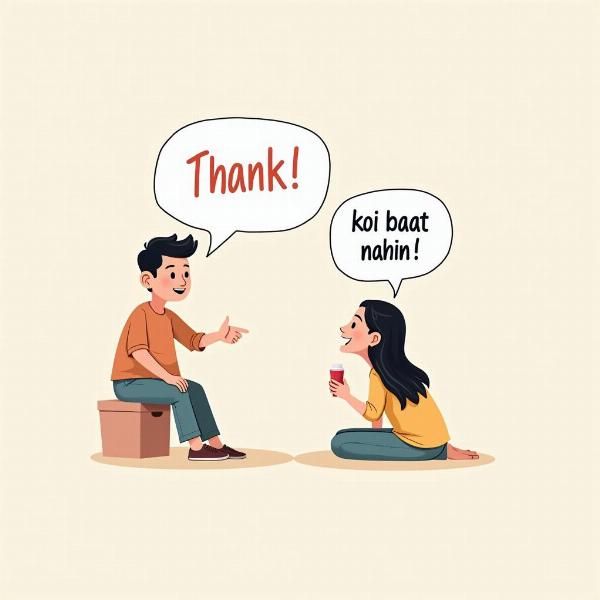Understanding how to respond to thanks is crucial in any language. If you’re learning Hindi or simply curious about how to reciprocate gratitude, you’ve come to the right place. This article delves into the various ways to say “you are welcome” in Hindi, exploring nuances and cultural contexts to ensure you choose the most appropriate phrase. We’ll cover formal and informal expressions, regional variations, and even non-verbal cues.
Different Ways to Say You Are Welcome in Hindi
Hindi offers a rich tapestry of responses to express “you are welcome.” Each carries its own subtle meaning and is best suited for particular situations. Let’s explore some of the most common options:
कोई बात नहीं (Koi Baat Nahin)
This is perhaps the most common and versatile way to say “you are welcome” in Hindi. It literally translates to “no problem” or “it’s nothing.” It conveys a sense of ease and downplays the favor, making it suitable for both formal and informal settings.
स्वागत है (Swagat Hai)
While technically meaning “welcome,” swagat hai can also be used as a response to thanks, especially in formal contexts or when welcoming someone into your home or business. It conveys a sense of hospitality and respect.
आपका स्वागत है (Aapka Swagat Hai)
This is the more formal and respectful version of swagat hai, incorporating the formal pronoun aap (you). Use this when addressing elders, superiors, or individuals you wish to show particular respect.
ज़रूर (Zaroor)
Meaning “certainly” or “of course,” zaroor can be used as a warm and friendly response to thanks. It implies willingness to help and creates a positive interaction.
खुशी हुई (Khushi Hui)
This translates to “I’m glad” or “it was my pleasure.” It expresses genuine happiness in having been able to assist and is particularly appropriate when you’ve done something you genuinely enjoyed.
 Informal "You're Welcome" in Hindi
Informal "You're Welcome" in Hindi
Regional Variations and Cultural Nuances
Like any language, Hindi has regional variations. While the phrases above are widely understood, certain expressions might be more prevalent in specific areas. For instance, koi bat nahi might be shortened to koi bat in some regions. Being mindful of these nuances can enhance your communication and show respect for local customs.
Non-Verbal Responses
Beyond spoken words, non-verbal cues also play a role. A simple smile and nod can often suffice, especially in informal situations. In more formal settings, a slight bow might accompany your verbal response.
You Are Welcome Meaning in Hindi: Choosing the Right Phrase
When deciding which phrase to use, consider the context of the conversation, your relationship with the person you’re speaking to, and the level of formality required. For everyday interactions with friends and family, koi baat nahin or zaroor are excellent choices. In more formal scenarios, opt for aap ka swagat hai or khushi hui.
How do you say “You’re most welcome” in Hindi?
For a more emphatic expression like “You’re most welcome,” you could say aap ka bahut swagat hai (आपका बहुत स्वागत है). This adds bahut (very) to amplify your welcome.
What is a polite way to say “you are welcome” in a business setting?
In a professional context, aap ka swagat hai or khushi hui are appropriate and polite choices.
Conclusion
Mastering the art of responding to thanks in Hindi is a valuable step in your language learning journey. By understanding the nuances of different expressions, you can navigate social interactions with grace and respect. So, whether you’re greeting a guest, responding to a colleague, or chatting with a friend, remember these helpful phrases to convey a heartfelt “you are welcome” in Hindi. This will not only enhance your communication but also deepen your appreciation for the richness of Indian culture.
FAQs
- What’s the most common way to say “you are welcome” in Hindi? Koi baat nahin is the most frequently used and versatile option.
- How do I say “you are welcome” formally in Hindi? Aapka swagat hai is the formal and respectful way.
- Can I just smile and nod instead of saying anything? Yes, in informal settings, a non-verbal response can be sufficient.
- Is there a Hindi equivalent for “my pleasure”? Khushi hui conveys a similar sentiment.
- Are there regional variations in how people say “you are welcome”? Yes, some phrases might be more common in certain areas.
- How do I respond to thanks in a business setting? Aapka swagat hai or khushi hui are suitable for professional contexts.
- What’s a more emphatic way to say “you are welcome”? Aapka bahut swagat hai (आपका बहुत स्वागत है) adds emphasis.
Meaning-Hindi.in is your trusted partner for professional Hindi translation services. We specialize in a range of translation needs, from business and legal documents to technical manuals and website localization. Our experienced team ensures accurate and culturally sensitive translations for various industries. Need fast and reliable Hindi translation? Contact us today at [email protected] or call us at +91 11-4502-7584. Meaning-Hindi.in provides expert translation services tailored to your specific needs.